Standard [CURRENT]
ASTM D 4953:2020
Standard Test Method for Vapor Pressure of Gasoline and Gasoline-Oxygenate Blends (Dry Method)
- German title
- Prüfverfahren für den Dampfdruck von Benzin und Benzin-Oxidationsmittel-Gemischen (Trockenverfahren)
- Publication date
- 2020
- Original language
- English
- Pages
- 8
- Publication date
- 2020
- Original language
- English
- Pages
- 8
- DOI
- https://dx.doi.org/10.1520/D4953-20
Product information on this site:
Quick delivery via download or delivery service
Buy securely with a credit card or pay upon receipt of invoice
All transactions are encrypted
Short description
1.1 This test method covers and is applicable to gasolines and gasoline-oxygenate blends with a vapor pressure range from 35kPa to 100kPa (5psi to 15psi) (see Note 2 ). This test method, a modification of Test Method D323 (Reid Method), provides two procedures to determine the vapor pressure ( Note 1 ) of gasoline and gasoline-oxygenate blends. Note 1: Because the external atmospheric pressure is counteracted by the atmospheric pressure initially present in the air chamber, this vapor pressure is an absolute pressure at 37.8°C (100°F) in kilopascals (pounds-force per square inch). This vapor pressure differs from the true vapor pressure of the sample due to some small vaporization of the sample and air in the confined space. Note 2: Vapor pressure of gasoline or gasoline-oxygenate blends below 35kPa (5psi) or greater than 100kPa (15psi) can be determined with this test method but the precision and bias (Section 11 ) do not apply. For materials with a vapor pressure greater than 100kPa (15psi), use a 0kPa to 200kPa (0psi to 30psi) gauge as specified in the annex of Test Method D323 . 1.2 Some gasoline-oxygenate blends may show a haze when cooled to 0°C to 1°C. If a haze is observed in 9.4 , it shall be indicated in the reporting of results. The precision and bias statements for hazy samples have not been determined (see Note 7 ). 1.3 The values stated in SI units are to be regarded as standard. The values given in parentheses are for information only. 1.4 This standard does not purport to address all of the safety concerns, if any, associated with its use. It is the responsibility of the user of this standard to establish appropriate safety, health, and environmental practices and determine the applicability of regulatory limitations prior to use. Specific warnings are given in 7.5 , 8.4.1 , 8.5.1 , 9.1 , A1.1 , and A1.1.3 . 1.5 This international standard was developed in accordance with internationally recognized principles on standardization established in the Decision on Principles for the Development of International Standards, Guides and Recommendations issued by the World Trade Organization Technical Barriers to Trade (TBT) Committee.
ICS
75.160.20
DOI
https://dx.doi.org/10.1520/D4953-20
Also available in
Loading recommended items...
Loading recommended items...
Loading recommended items...
Loading recommended items...

